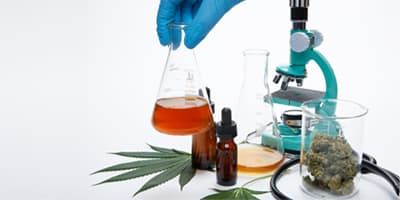Most well-seasoned cannabis connoisseurs know that hitting a bong and puffing on a vaporizer will generate a different kind of high. But for the novice-level consumer or medical marijuana patient, the difference between combustion and vaporization might not seem as pertinent. Even everyday tokers might not fully understand the science behind these popular forms of consumption.
Combustion can be simply defined as the process of burning something, in this particular case cannabis. Vaporization, on the other hand, is a slightly more complex process that encompasses a phase transition from liquid to vapor.
Some people might make the surface level argument that “vaping is obviously safer than smoking” and call it a day, but the science and health-related factors behind combustion and vaporization are often unknown or misrepresented.

There is a growing amount of research vying to identify the actual benefits and disadvantages of these consumption methods. As researchers continue to unearth new insights, understanding the differences between combustion and vaporization begins to improve.
Scientific Approach to Combustion vs. Vaporization
When you look at the differences between combustion and vaporization, the most critical factor to take into account is the temperature used for each method. Most vaporization devices will heat the cannabis just below the point of combustion, which ranges between 180 to 190 degrees Celsius (356 to 374 degrees Fahrenheit). On the other hand, a lighter will produce an open flame that can reach more than 315 degrees Celsius, or 600 degrees Fahrenheit, an extremely high temperature that will boil away a substantial amount of cannabinoids and terpenes before the cannabis is even consumed.
Vaping cannabis increases the amount of cannabis compounds that are activated, which could potentially enhance some of the health benefits for medical marijuana patients.
A 2009 study, published in Inhalation Toxicology, looked into the medicinal qualities of cannabis through various consumption methods. Using high-performance liquid chromatography (HPLC), the researchers analyzed the variance between the cannabis by-products generated from a Volcano vaporizer and traditional “cannabis cigarette smoke.” Again, the primary facet here was the temperature used to vaporize the cannabis.
“The cannabinoids:byproducts ratio in the vapor obtained at 200 degrees C and 230 degrees C [392 to 446 degrees Fahrenheit] was significantly higher than in the cigarette smoke. The worst ratio of cannabinoids:byproducts was obtained from the vaporized cannabis sample at 170 degrees C [338 degrees Fahrenheit],” the study stated.
Temperature also has an impact on the flavor and aroma of cannabis. Different terpenes have specific boiling points, so the lower the temperature, the more flavor and aroma is likely to be present. One advantage of vaporization that is usually understated is that many devices give users the ability to fine-tune the temperature to optimize the cannabis consumption experience.
Effects of Combustion and Vaporization on Health
While research into the long-term health effects of vaping is still lacking, it's generally accepted that vaporization is safer than smoking. For medical patients in particular, inhaling any combusted plant material, including cannabis products, is considered to be a health risk.
Vaporization produces fewer carcinogenic compounds than combustion and may even help eliminate toxic and potentially carcinogenic compounds that are created as a result of combustion. A 2001 study conducted by the National Organization for the Reform of Marijuana Laws (NORML) and the Multidisciplinary Association for Psychedelic Studies (MAPS) concluded that cannabis vaporization devices could suppress carcinogenic compounds that are found in cannabis smoke, such as benzene, naphthalene, and toluene.

There is some merit to the perceived health benefits that vaporization offers. One study, published in the Harm Reduction Journal in 2007, examined self-reported respiratory symptoms in participants who used cigarettes and cannabis. The findings suggested that using a vaporizer could increase the amount of cannabis that is consumed but could also decrease respiratory symptoms in regular cannabis users who smoke.
“Cannabis smoking can create respiratory problems. Vaporizers heat cannabis to release active cannabinoids, but remain cool enough to avoid the smoke and toxins associated with combustion. Vaporized cannabis should create fewer respiratory symptoms than smoked cannabis,” the study stated.
In a 2014 survey, researchers found that most cannabis consumers consider vaporization to be more healthful and less harmful than smoking, which has increased its appeal for both medical patients and recreational cannabis consumers.
These initial findings might support the notion that vaporization is safer than combustion, but more experimental research is needed to evaluate that actual health-related effects of this popular delivery method.




